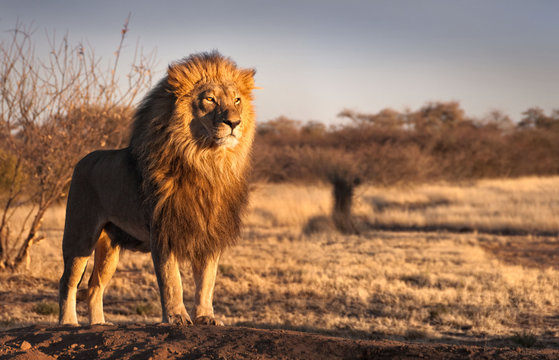Features and facts
Lion, (Panthera leo), large, powerfully built cat (family Felidae) that is second in size only to the tiger; it is a famous apex predator (meaning without a natural predator or enemy). The proverbial “king of beasts,” the lion has been one of the best-known wild animals since earliest times. Lions are most active at night and live in a variety of habitats but prefer grassland, savanna, dense scrub, and open woodland. Historically, they ranged across much of Europe, Asia, and Africa, but now they are found mainly in parts of Africa south of the Sahara. An isolated population of about 650 Asiatic lions constitute a slightly smaller race that lives under strict protection in India’s Gir National Park and Wildlife Sanctuary.
Prides
Lions are unique among cats in that they live in a group, or pride. The members of a pride typically spend the day in several scattered groups that may unite to hunt or share a meal. A pride consists of several generations of lionesses, some of which are related, a smaller number of breeding males, and their cubs. The group may consist of as few as 4 or as many as 37 members, but about 15 is the average size. Each pride has a well-defined territory consisting of a core area that is strictly defended against intruding lions and a fringe area .
prey and meals
Lions prey on a large variety of animals ranging in size from rodents and baboons to Cape (or African) buffalo and hippopotamuses, but they predominantly hunt medium- to large-sized hoofed animals such as wildebeests, zebras, and antelopes. Prey preferences vary geographically as well as between neighbouring prides. Lions are known to take elephants and giraffes, but only if the individual is young or especially sick. They readily eat any meat they can find, including carrion and fresh kills that they scavenge or forcefully steal from hyenas, cheetahs, or wild dogs. Lionesses living in open savanna do most of the hunting, whereas males typically appropriate their meals
Breeding
Both sexes are polygamous and breed throughout the year, but females are usually restricted to the one or two adult males of their pride. In captivity lions often breed every year, but in the wild they usually breed no more than once in two years. Females are receptive to mating for three or four days within a widely variable reproductive cycle. During this time a pair generally mates every 20–30 minutes, with up to 50 copulations per 24 hours. Such extended copulation not only stimulates ovulation in the female but also secures paternity for the male by excluding other males. The gestation period is about 108 days, and the litter size varies from one to six cubs, two to four being usual.

